
Goondiwindi War Memorial is a heritage-listed war memorial at Marshall Street, Goondiwindi, Goondiwindi Region, Queensland, Australia. The memorial includes a life-sized statue of a Digger and memorial gates . It is also known as Memorial Gates and The Soldiers' Memorial. It was added to the Queensland Heritage Register on 21 October 1992.

Cooyar War Memorial is a heritage-listed war memorial in Hack Menkins Park, McDougall Street, Cooyar, Toowoomba Region, Queensland, Australia. The memorial was unveiled on Saturday 14 July 1923 by Arthur Edward Moore. It was designed and produced by R. C. Ziegler and Son and cost £413/10/0, with funds raised by public subscriptions and revenue raised from entertainments. The memorial comprises two pieces, the pedestal surmounted by a digger statue, on which the names of the 25 fallen are recorded, and a smaller plinth which records the names of the 110 local men who served in World War I. It was added to the Queensland Heritage Register on 21 October 1992.

Greenmount War Memorial is a heritage-listed memorial at Ramsay Street, Greenmount, Toowoomba Region, Queensland, Australia. It was unveiled 11 December 1922. It was added to the Queensland Heritage Register on 21 October 1992.

Boer War Memorial is a heritage-listed war memorial at Crescent Street, Gatton, Queensland, Australia. It was designed by William Hodgen and produced by Toowoomba mason William Bruce. It was built in 1908, and was unveiled on 3 August by Governor of Queensland, Lord Chelmsford. The memorial honours four local men who died in or as a result of the Boer War, and is one of only three known Boer War memorials in Queensland. It is also known as the Fallen Soldiers Memorial and the South African War Memorial.
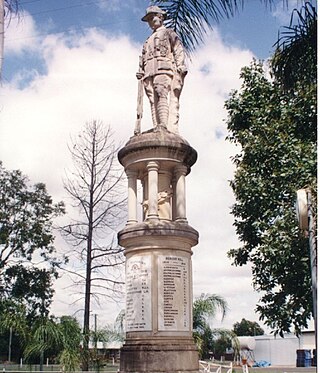
Forest Hill War Memorial is a heritage-listed memorial at Gordon Street, Forest Hill, Lockyer Valley Region, Queensland. Australia. It was built in 1921. It is also known as Forest Hill Soldiers Memorial. It was added to the Queensland Heritage Register on 21 October 1992.

Ma Ma Creek War Memorial is a heritage-listed memorial on the Gatton-Clifton Road, Ma Ma Creek, Queensland, Australia. It was completed in 1920. It was added to the Queensland Heritage Register on 21 October 1992.

Beaudesert War Memorial is a heritage-listed memorial at William Street, Beaudesert, Queensland, Australia. It was built from 1919 to 1921. It was added to the Queensland Heritage Register on 21 October 1992.
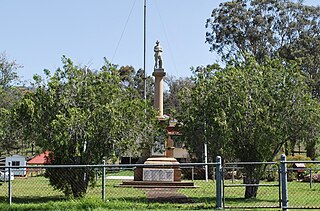
Maroon War Memorial & Memorial Enclosure is a heritage-listed memorial at Boonah - Rathdowney Road, Maroon, Scenic Rim Region, Queensland, Australia. It was designed and built in 1920 by Frank Williams and Co. It was added to the Queensland Heritage Register on 21 October 1992.
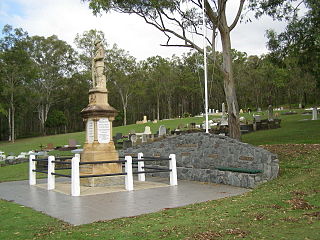
Pimpama & Ormeau War Memorial is a heritage-listed memorial at Pacific Highway, Pimpama, Queensland, Australia. It was built in 1919. It was added to the Queensland Heritage Register on 21 October 1992.
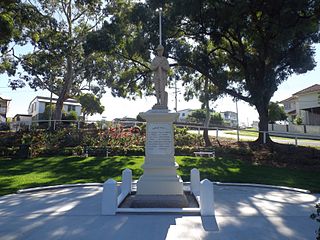
Manly War Memorial is a heritage-listed memorial at 184 Carlton Terrace, Manly, City of Brisbane, Queensland, Australia. It was built from 1920 to 1921. It is also known as Ferguson Street Reserve, Manly Dam, and Soldiers Memorial Park. It was added to the Queensland Heritage Register on 21 August 1992.

Oxley War Memorial is a heritage-listed memorial at 1218 Oxley Road, Oxley, Queensland, Australia. It was built in 1920. It is also known as Oxley Memorial Park and Oxley Place. It was added to the Queensland Heritage Register on 4 July 2006.

Booval War Memorial is a heritage-listed memorial at Green Street, Booval, City of Ipswich, Queensland, Australia. It was built in 1919. It was added to the Queensland Heritage Register on 21 October 1992.

The Boer War Memorial is a heritage-listed memorial at Warwick Street, Allora, Southern Downs Region, Queensland, Australia. It was built from 1904 to 1940s. It is also known as Queen's Park and War Memorial Park. It was added to the Queensland Heritage Register on 21 October 1992.

Ipswich Railway Workshops War Memorial is a heritage-listed memorial at the North Ipswich Railway Workshops, North Street, North Ipswich, City of Ipswich, Queensland, Australia. It was designed by Vincent Price and built in 1919. It was added to the Queensland Heritage Register on 21 October 1992.

Apple Tree Creek War Memorial is a heritage-listed memorial at Bruce Highway, Apple Tree Creek, Bundaberg Region, Queensland, Australia. It was designed and built in 1921 by Andrew Lang Petrie. It was added to the Queensland Heritage Register on 21 October 1992.

Bundaberg War Memorial is a heritage-listed memorial at Bourbong Street, Bundaberg Central, Bundaberg, Bundaberg Region, Queensland, Australia. It was designed by Frederic Herbert Faircloth and built from 1920 to 1921 by Anselm & Odling (Sydney). It was added to the Queensland Heritage Register on 21 October 1992.

Sarina War Memorial is a heritage-listed memorial at Broad Street, Sarina, Mackay Region, Queensland, Australia. It was built in 1919 by Melrose and Fenwick. It was added to the Queensland Heritage Register on 5 December 1997.

Barcaldine War Memorial Clock is a heritage-listed memorial at Ash Street, Barcaldine, Barcaldine Region, Queensland, Australia. It was designed and built in 1924 by monumental masons Andrew Lang Petrie and Son. It was added to the Queensland Heritage Register on 21 October 1992.
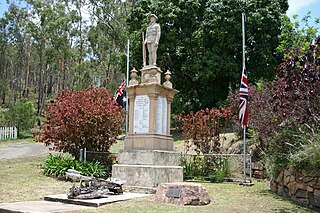
Herberton War Memorial is a heritage-listed memorial at Myers Street, Herberton, Tablelands Region, Queensland, Australia. It was designed and built by Andrew Lang Petrie and Son in 1922. It was added to the Queensland Heritage Register on 21 October 1992.
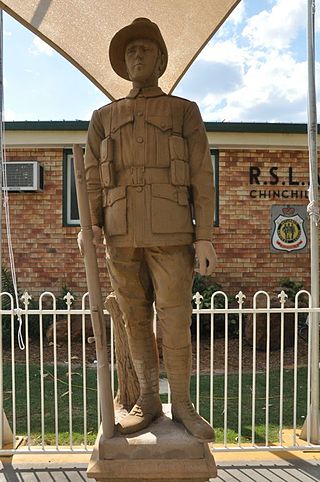
The Digger Statue is a heritage-listed memorial at 57 Heeney Street, Chinchilla, Western Downs Region, Queensland, Australia. It was designed by Andrew Lang Petrie and built in 1919 by A L Petrie & Son. It is also known as Chinchilla WWI Memorial and Chinchilla Soldier Statue. It was added to the Queensland Heritage Register on 1 August 1999.





















